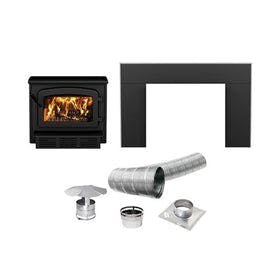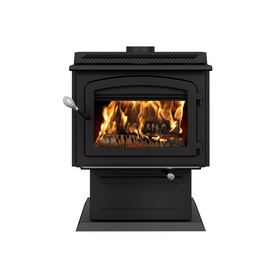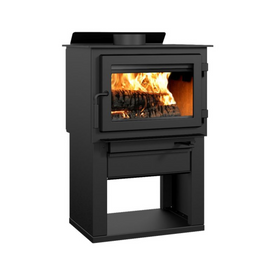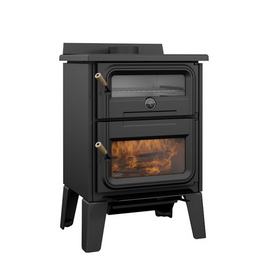Tanner Sagouspe

How to Build a Simple Wood-Fired Oven
Last Updated: Apr 13, 2025Wood-fired ovens used to be a staple in every home, where families could cook delicious meals, warm their houses, and heat water for the washing basin. Today, it is possible to find modern, high quality cast iron wood stoves that can function as an alternative heating method for your home. However, those large cast-iron centerpieces where families cooked every meal are today mostly relics in antique stores.
Making a wood-fired oven is a fast and relatively simple DIY home project that can be completed in a few weekends, even if you aren’t an accomplished mason or builder.
Why Do You Need a Wood-Fired Oven?
Perhaps the better question is: Why don’t you? Most of us probably don’t have a lot of experience cooking with wood. If you have ever tasted a wood-fired pizza, however, you probably understand that cooking with wood offers a different taste and can expand the culinary possibilities of even a novice cook.
Wood-fired ovens can be beautiful, artistic creations that can bring life to an otherwise dull and ordinary outdoor patio. A wood-fired oven can transform outdoor patios and gardens, extend your kitchen and dining area, and allow you to take advantage of outdoor spaces even during the winter.
Of course, wood-fired ovens also offer warmth. Its heat can warm an attached sunroom or provide ambient heating for outdoor areas during colder months.
Wood-fired ovens are fun, inexpensive, and relatively easy to build. Below, we will look at three different possibilities to create an economical, practical, and aesthetically pleasing wood-fired oven for your home.
The Sustainability of Cooking with Wood
In the United States, about three out of every four households own a grill or smoker, but almost nobody relies on wood for their primary cooking needs. While our grandmother's generation might have continued the practice of cutting firewood early in the morning to have fuel for the day's meals, today, the vast majority of households cook with either natural gas (40 percent of households) or electricity.
Cooking every meal with wood does have its drawbacks. For starters, the process of starting up a fire every time you want to heat water for a quick coffee will most likely not fit with our hectic schedules. But cooking with wood does still offer certain sustainability benefits.
Cooking with wood is often associated with pollution, mostly because homeowners can physically see the smoke rising from the burning wood. While thousands of households in a dense urban area, all cooking with wood could cause dangerous problems with urban air pollution, natural gas stoves and ovens are also responsible for enormous methane emissions. Though less visible, these methane emissions are a significant contributor to global climate change and are another reason that homeowners should consider transitioning to an all-electric home.
Whether for home heating for cooking purposes (or for both simultaneously—an added advantage), Burning wood is essentially a carbon-neutral solution. The growth of the trees initially captured the carbon released during the burning of the wood. If those trees grew in degenerated environments, much of the carbon would most likely accumulate in the soil by increasing soil organic matter and soil organic carbon. That means that burning wood for fuel might even be carbon positive. An electric range powered by a carbon zero home cannot claim the same, as solar panels come with a sizeable embodied energy footprint.
A Few Different Wood-Fired Oven Options
Whether you want to find a cooking solution that will help you reduce your carbon footprint or want to try your hand at baking a wood-fired pizza, we offer three simple step-by-step guides for building three different types of wood-fired ovens.
Table of Contents
- What Is an Italian Brick Oven?
- What Is a Cob Oven?
- How Do You Make a Cob Oven?
- What Is a Metal Barrel Oven?
- How Do You Make a Metal Barrel Oven?

What Is an Italian Brick Oven?
An Italian brick oven offers an authentic-looking centerpiece for any outdoor deck or eating area that is also extremely functional. Even if you are not an accomplished mason, a simple Italian brick oven can be made following the steps outlined below for building a cob oven. Once you have your base and build the mound of wet sand (essentially a giant sandcastle), you will make around that mound with firebrick instead of cob.
You will need to make a simple mortar from two parts fine sand, one part Portland cement, and one part lime. Build up slowly around the mount of sand, and make sure to leave a space for the door. Let the mortar dry around each level that you build up. You will want to use a wooden form around the door frame that you can remove once the mortar has completely dried out. When the mortar has cured, remove the sand from the door opening and fire slowly for several days before using it.

What Is a Cob Oven?
Cob is a building technique used for decades to construct durable, sustainable homes that last hundreds of years. It relies on a mixture of clay, sand, and straw to create a monolithic structure with an enormous amount of thermal mass. The same material used for building the walls of your home can also make a simple, DIY wood-fired oven.
How Do You Make a Cob Oven?
- Just as with the Italian brick oven, start by building a base for the oven. This base can be from rock, brick, block, or any other resistant material that raises the oven to a height that is easy to access.
- Lay a foundation of fire brick, which will act as the base for the oven.
- Above the fire brick, build a mound with wet sand. This mound should be the same size as the interior of the oven.
- Cob is ideally 75 percent sand and 25 percent clay. You can check the content of your soil composition by doing a bottle test. Take a handful of soil, place it in a clear glass container, add water, and shake it up. The sand content of the soil, which is heaviest, will sink to the bottom while the clay will settle on top of the sand. These proportions will give you a ratio of the sand to clay in your soil. If you have heavy clay soil, add some river sand to the mix.
- On top of a tarp, mix the cob that is going to be the walls of your oven. Add a bit of water and stomp on the soil with your bare feet or rubber boots. When mixed, add a healthy amount of straw that will offer tensile strength.
- Once you have your cob mixed, begin to place it around the outside of the sand dome that you built on top of your fire brick floor. Make the walls between 4 and 6 inches thick. Continue until you have entirely covered the dome. You should now have a dome of cob surrounding the inner layer of sand.
- After several days of drying out, and before the cob completely hardens, take a knife and cut out a doorway to your oven. You will also want to cut an opening for the chimney on top of the dome. Let the cob dry for a few more days and then, with a mason's trowel, scoop out the dry sand. You should be left with a hollow dome.
- When the cob is completely dry, you can add a metal door, the metal chimney, and decorate your cob oven as you see fit. If it isn’t under a roof, you will need to protect it from rain and snow through either covering it with a tarp or adding a layer of cement.
- Fire the oven slowly the first few times to get the hang of achieving the ideal temperature.
It is also possible to substitute the cob for a dome made entirely from fire bricks. This takes a bit more masonry skills but will allow you to end up with a beautiful oven that will be reminiscent of traditional Mediterranean bakeries.
Fireplaces & Stoves
Find a wide variety of researched and vetted wood stoves products that help address heating and home comfort.

Drolet Escape 1800-I Wood Stove Insert Trio (25ft) DB03127K
Drolet
Out of Stock

Drolet HT-3000 Wood Burning Stove DB07300
Drolet
Out of Stock

Drolet Escape 1500-I Wood Insert Trio (25 FT) DB03137K
Drolet
Out of Stock

Drolet Escape 1800-I Wood Insert DB03125
Drolet
In Stock

Drolet Deco II Wood Stove DB03205
Drolet
In Stock

Drolet Escape 1800-I Wood Insert Trio (35 FT) DB03128K
Drolet
In Stock

Drolet Bistro Wood Burning Cookstove DB04815
Drolet
In Stock

Drolet Escape 1500-I Wood Insert Trio (35 FT) DB03137K3
Drolet
Out of Stock

Drolet Deco Nano Wood Burning Stove DB03215
Drolet
In Stock

Drolet Columbia II Wood Burning Stove DB03016
Drolet
Out of Stock

What Is a Metal Barrel Oven?
Metal barrel ovens are a great example of upcycling and use a 35 or 55-gallon drum or barrel to make a beautiful wood-fired oven. Unlike traditional wood ovens, recycled metal barrel ovens can heat up in just 15-20 minutes which makes for quicker and more efficient baking.
How Do You Make a Metal Barrel Oven?
- Start with a used steel barrel. With an angle grinder and metal cutting disk, cut out a door and a chimney top. You can purchase a cast-iron barrel stove kit that will help you determine the size of the holes while also helping you avoid the work of creating a door from scratch.
- Once you have cut out the doors, you will want to build a fire pit from fire brick underneath the barrel. The firebox should allow the heat to hit the bottom and sides of the metal barrel for quick heating.
- Surrounding the metal barrel and the firebox will be masonry fill. This could be rock, brick, or even cob. The extra thermal mass will store the heat from the fire and allow the barrel oven to cook whatever is inside efficiently.
- Inside the oven, you should add two deep shelves that will maximize the amount of space you have for building.
- Finally, add the chimney to the hole in the barrel stove, and you're finished.
Whether you choose to build a metal barrel stove, a cob stove, or an authentic Italian brick oven, you can add several artistic touches. This will allow your wood-fired oven to become a centerpiece of your patio while offering numerous functional benefits.
Tobias Roberts
Tobias runs an agroecology farm and a natural building collective in the mountains of El Salvador. He specializes in earthen construction methods and uses permaculture design methods to integrate structures into the sustainability of the landscape.









